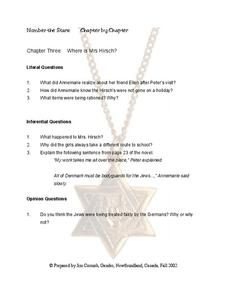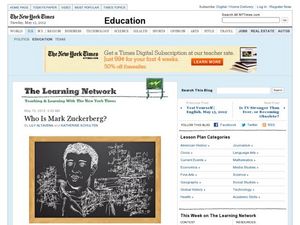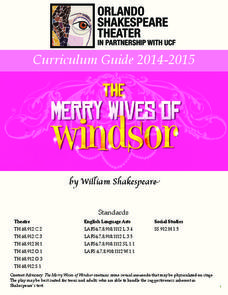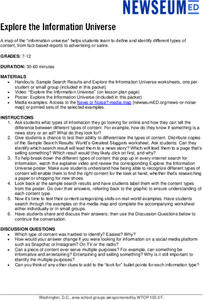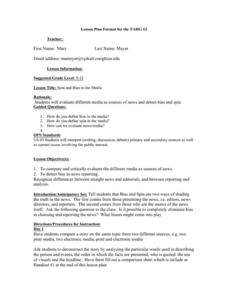C-SPAN
Voting Discrimination and the Effects of Shelby County v. Holder
Show students that every vote counts as they debate the federal government 's role in protecting voting rights in historically racially discriminated areas. In the Supreme Court case Shelby County v. Holder, the high court found...
Curated OER
Number the Stars Chapter 16
In this Language Arts activity, students answer three questions from Number the Starts, Chapter 16. The questions include one literal question, one inferential, and one opinion question.
Curated OER
Number the Stars Chapter 2
In this Language Arts worksheet, students answer three questions from Number the Stars, Chapter 2. The questions include 3 literal, 4 inferential, and 2 opinion questions.
Curated OER
Number the Stars Chapter 3
For this Language Arts worksheet, students answer three questions from Number the Stars, Chapter 2. The questions include 3 literal, 3 inferential, and 1 opinion question.
Curated OER
Number the Stars Chapter 4
In this Language Arts worksheet, students answer three questions from Number the Stars, Chapter 2. The questions include 3 literal, 2 inferential, and 2 opinion questions.
Curated OER
Number the Stars Chapter 5
In this Language Arts worksheet, learners answer three questions from Number the Stars, Chapter 2. The questions include 6 literal, 1 inferential, and 3 opinion questions.
Curated OER
Number the Stars Chapter 12
For this Language Arts worksheet, students answer three questions from Number the Stars, Chapter 12. The questions include 4 literal,1 inferential, and 1 opinion question.
Curated OER
Number the Stars Chapter 10
In this Language Arts worksheet, students answer three questions from Number the Stars, Chapter 10. The questions include 4 literal, 2 inferential, and 3 opinion questions.
Curated OER
Number the Stars Chapter 11
For this Language Arts worksheet, students answer three questions from Number the Stars, Chapter 11. The questions include 2 literal, 2 inferential, and 1 opinion question.
Curated OER
Number the Stars Chapter 14
In this Language Arts learning exercise, students answer three questions from Number the Stars, Chapter 14. The questions include 2 literal, 2 inferential, and 1 opinion question.
Curated OER
Number the Stars Chapter 13
In this Language Arts worksheet, students answer three questions from Number the Stars, Chapter 13. The questions include 2 literal, 1 inferential, and 2 opinion questions.
California Education Partners
Telescopes
An assessment challenges scholars to read an informative text then respond with an explanatory essay. The exam begins as participants read a text passage twice then take notes, making sure to jot down key details. Following the...
Teach Engineering
What is Going on with Grandma?
Pupils individually determine what they need to know about osteoporosis and how they will find that information. They share their thoughts with a partner before moving on to share with the class. The class arrives at a list of a set of...
Curated OER
Who is Mark Zuckerberg?: Reading Informational Text
This New York Times "Learning Network" exercise provides 10 questions that apply to an article about Mark Zuckerberg. It poses key journalistic questions like, who, what, why, where, how, and when. This resource provides a nice, short...
Concord Consortium
Intermolecular Attractions and Boiling Point
Why do different substances have different boiling points? Through an interactive lesson, learners explore how intermolecular attractions affect boiling points. They interact with molecules through an animation and make conclusions about...
EngageNY
End-of-Module Assessment Task: Grade 7 Mathematics Module 5
Show learners how to use simulations and random sampling to reach conclusions with the last resource in a 25-part series. The assessment contains three scenarios, each with several parts, and covers comparing populations using...
Penguin Books
A Teacher’s Guide to the Signet Classic Edition of George Orwell’s 1984
Whether you're new to using Nineteen Eighty Four in the classroom or you're an Orwell veteran, the materials in this teacher's guide are a valuable addition to your curriculum. The suggested activities prompt readers to create a newspeak...
Orlando Shakes
Merry Wives of Windsor: Study Guide
What does the character Falstaff mean when he says "I was beaten myself into all the colors of the rainbow"? Using the Merry Wives of Windsor curriculum guide, scholars unlock meaning by paraphrasing lines from the play. Pupils also...
Orlando Shakes
Shakespeare in Love: Study Guide
What word has two syllables and means a ray of moonlight? If young readers guessed moonbeam, they are correct! With the Shakespeare in Love study guide, participants test their guessing skills in an exciting game of Shakespeare Taboo...
Curriculum Corner
Observational Drawing
What shall we write about today? The opportunities are endless with a printable that offers space to write and draw a corresponding picture.
Facing History and Ourselves
Free Press Makes Democracy Work
A unit study of the importance of a free press in a democracy begins with class members listening to a podcast featuring two journalists, one from a United States public radio station and one from Capetown, South Africa. The lesson,...
Newseum
Explore the Information Universe
Distinguishing among different types of content when conducting online searches can be a challenge. An informative resource helps researchers identify different types of content, from fact-based reports to ads, from propaganda to satire....
Curated OER
Electrifying Franklin
Fourth graders research and present information about Benjamin Franklin's life and accomplishments. For this lesson on Benjamin Franklin, 4th graders review idioms and sayings written by Franklin then compare and contrast his various...
Curated OER
Spin and Bias in the Media
Students compare different types of media. In this media comparison instructional activity, students will assess the where all types of media gets its information by viewing a video of a news story and critiquing it.



